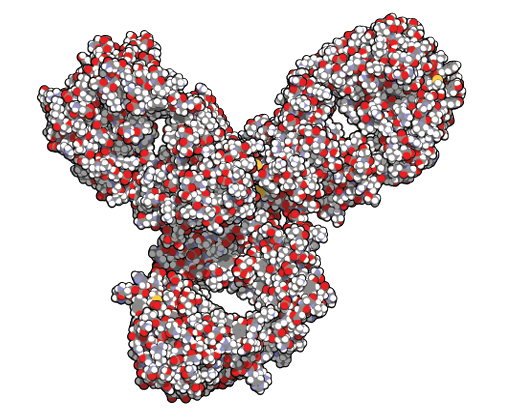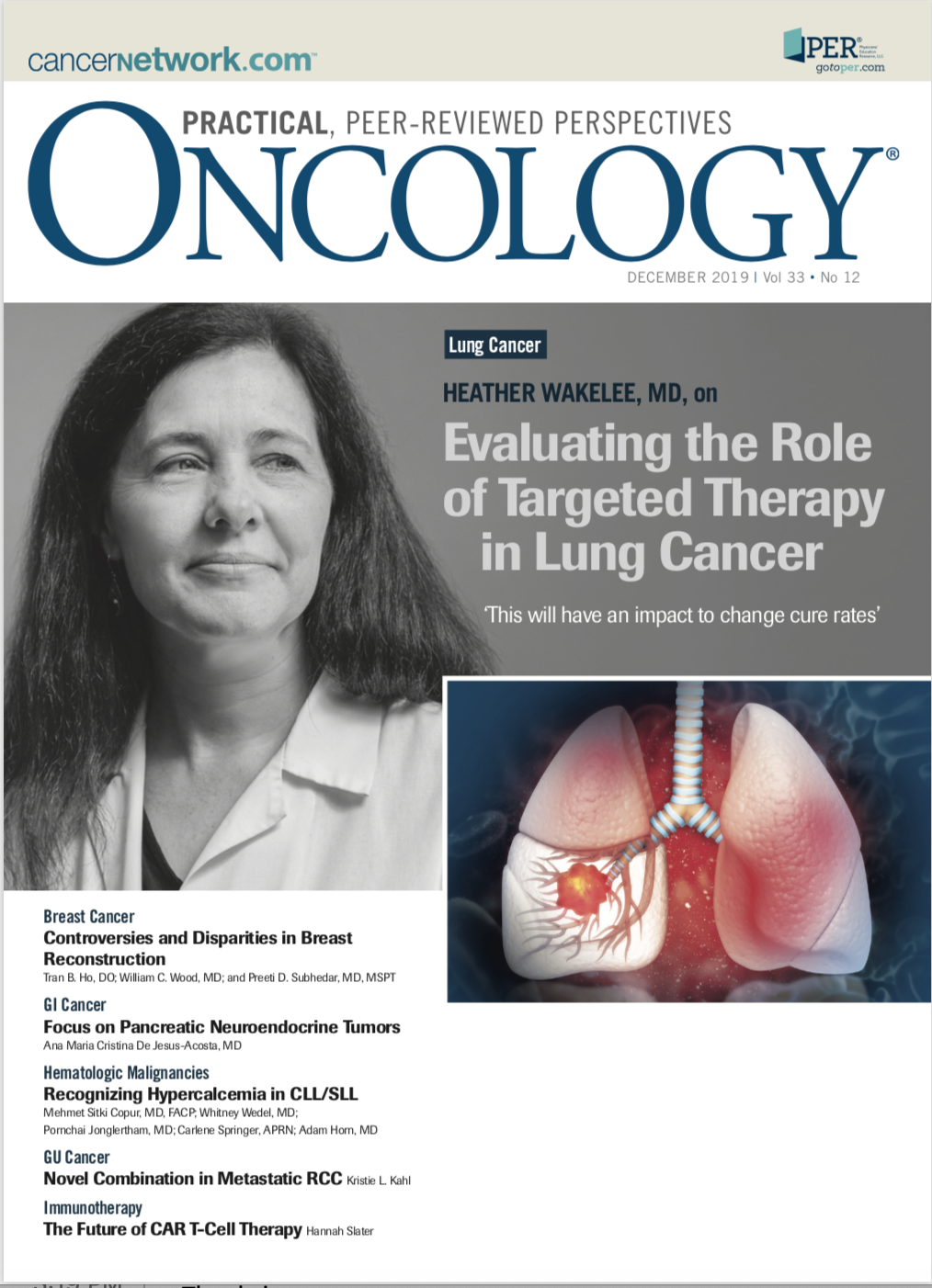Evaluating the Role of Targeted Therapy in Lung Cancer
ONCOLOGY recently sat down with Heather Wakelee, MD, to discuss major trends in lung cancer, such as treatment advances, updates in genetic testing, the unknown risks of vaping, and where the field is headed next.
Heather Wakelee, MD, is a professor of medicine in the division of oncology at Stanford University and is the faculty director of the Stanford Cancer Clinical Trials Office.

Pembrolizumab is an immune checkpoint inhibitor designed to target PD-1.

PD-L1 is produced by tumors to suppress the immune system. Blockers of the PD-L1 and PD-1 interaction are an important new anticancer drug class to treat lung cancer.

“This will have an impact to change cure rates.”
ONCOLOGY recently sat down with Heather Wakelee, MD, ahead of the 17th Annual Winter Lung Cancer Conference being held February 7-9, 2020, where she will serve as a co-chair for the meeting. Wakelee, an associate professor of medicine (oncology) at Stanford University Medical Center, discussed major trends in lung cancer, such as treatment advances, updates in genetic testing, the unknown risks of vaping, and where the field is headed next. She also described why it is important for oncologists to attend the program led by world-class thoracic oncologists.
Treatment Advances
Q: How would you characterize the major trends in lung cancer treatment research right now? Is there an overarching theme you see in clinical development, particularly a theme that is going to be reflected in the lung cancer conference?
Dr. Wakelee: When we think about lung cancer, we have to think about it in different phases: prevention and early detection, early stage, improving cure rates in early stages, and then we have to think about metastatic disease.
Prevention and early detection, there’s obviously a lot happening now around vaping. And most of that, of course, focuses on these acute illnesses. But there is a growing, albeit still small, body of literature about the links to cancer. I do not think any of us that work in the healthcare field are in any way surprised that there is going to be a cancer link; it is something that has been suppressed thus far by the companies involved. But that is definitely something where there is going to be more research coming out.
For early detection, there is a lot of screening with scans, but also a lot of what is being done with circulating tumor DNA and other nonradiographic techniques for early detection. When we think about earlier stages of disease, targeted therapies are being discovered and looked at there, although we do not have any definite proof. With the immune therapies, there is even more excitement, and we have definite proof of principle with the PACIFIC trial. of In that study, patients with stage III disease received durvalumab (Imfinzi), a checkpoint inhibitor, after chemotherapy radiation and clearly showed an improvement in cure.
Now there is a lot of trials with immune checkpoint inhibitors given before surgery or after surgery, alone or in combination with chemotherapy. We are yet to see the sort of survival details from those trials, but we are seeing some very encouraging preliminary data. So that is likely going to continue to evolve quite a bit.
When we talk about metastatic disease, we also focus back on those immune therapies. They are already clearly established as a standard treatment for patients who do not have a driver mutation in their cancer. We give them alone or in combination with chemotherapy as a first-line treatment now for anybody who does not have a driver mutation or a reason they cannot receive one of those drugs.
The challenge we face now is what to do when those drugs stop working. So, there are many ongoing trials looking at various combinations of other immune-altering drugs that are not the standard programmed cell death protein 1 (PD-1) and programmed cell death-ligand 1 (PD-L1) checkpoint inhibitors. There was just some data out with the cytotoxic T-lymphocyte-associated protein 4 and PD-1 checkpoint inhibitors, ipilimumab (Yervoy)/nivolumab (Opdivo), respectively, that were very encouraging. But what we are really trying to do is figure out what to do when an immune therapy does not work for a patient or when it worked and stopped working. That is where a lot of the research is focused.
A separate group of patients are those with targetable mutations in their tumors. We have known about EGFR, ALK, ROS, but now there are more and more data coming out in some of the less common types such as HER2, RET, and NTRK. There are also some data with 1 of the subtypes of KRAS. So, those molecularly targeted treatments are still rapidly evolving as well.
Q: What targeted therapies have recently been approved? What results are you most eagerly anticipating?
Dr. Wakelee: Every few months it seems that we are hearing about new targeted agents. The one that everyone is talking about right now is AMG 510, and there’s also a similar compound made by Mirati. These agents are targeting 1 particular subset of KRAS, which is a big target because it is responsible for a huge percentage of adenocarcinoma, and was previously thought to be fairly resistant to therapy.
There are multiple, different KRAS mutations, and this one that is being investigated is the KRAS G12C mutation, and the C part of that is important. It is very limited to that one particular subset, but it’s a fairly big subset of a very big subset of lung cancer. So, that is very exciting. We still are only seeing data from dozens of patients as opposed to hundreds of patients, and it is not clear when we are going to get FDA approval. However, because it is the first step in that direction, it is likely going to be relatively soon. We will have to see. And, it is not something that works for all KRAS mutations. It works for KRAS lung cancer, but it does not look like it is working for KRAS-positive colon cancer. I haven’t seen any data with KRAS-positive melanoma. That is why there is a lot of excitement around it, because so many different diseases can be impacted.
Q: How do you decide who gets immunotherapy with chemotherapy and who does not?
Dr. Wakelee: Right now, it is still based on the PD-L1 level, and so if someone has a very high PD-L1 level, we will go ahead and give single-agent pembrolizumab (Keytruda). If they don’t have a very high PD-L1 level, we usually give pembrolizumab in combination with chemotherapy. If, on the other hand, someone has an EGFR, ALK, ROS1, or RET mutation, or many of these other driver mutations, we know that even if they have high PD-L1 expression, they are still not likely to respond to a checkpoint inhibitor, and so we ignore PD-L1 expression. For patients who do not have a driver mutation, we look at PD-L1 expression. If it is high, if the patient is not very symptomatic from their disease, we are comfortable giving single-agent immunotherapy. If they are symptomatic, then we would consider giving pembrolizumab with chemotherapy because the response rates are higher.
Now it gets more complicated because we just saw the IMpower110 trial data at the European Society for Medical Oncology Congress and atezolizumab (Tecentriq) was also active as a single agent compared with chemotherapy when PD-L1 expression was high. They used a slightly different test, however. Also, a nivolumab/ipilimumab combination showed activity regardless of PD-L1 expression or tumor mutation burden. But, it still was not active in everybody, and there is some question about how we select out the patients who might be best served with that combination as opposed to chemotherapy or other combination regimens.
Genetic/Genomic Testing
Q: When can providers use a general diagnostic to decide on a patient’s treatment course?
Dr. Wakelee: Well, we always need to make sure that appropriate testing has been done to understand the molecular basis of the tumor, especially for someone with metastatic disease. It is not enough to just know PD-L1 expression. You have got to know the standard driver mutations. Then, you have enough information to make that first-line treatment choice, and that is going to be standard driver mutation drugs, chemotherapy, or chemotherapy plus immune therapy. That can be sorted out (if it is one of the standards) by almost any oncologist who manages lung cancer. But, when we get into the rare subtypes, patients really need to talk to someone who is a lung cancer specialist. And, it is important at the time of progression. That is where there is a lot of variations that can occur, and that is where the specialist can usually provide some good insight.
Vaping
Q: What do we know about vaping and its unknown risks?
Dr. Wakelee: There are some data supporting that vaping is somewhat less toxic than smoking cigarettes. Also, there are some data for people who were smoking cigarettes and are able to switch from smoking cigarettes to vaping. Less data exists for how many of those patients can go from vaping to not having any tobacco consumption or any nicotine consumption.
What we worry about more is that there is clearly an epidemic of more young people taking up vaping who would not have otherwise taken up any sort of a nicotine habit. It might be less harmful than a cigarette but it is not harmless.
We as a healthcare community are facing the challenge that the marketing of e-cigarettes has been so powerful that it messages that e-cigarettes can help people quit smoking. They have done a lot of opinion polls in young people and otherwise healthy people, where people have the sense, “Oh yes, it’s harmless,” which is exactly what the tobacco industry was trying to get us to believe. Now there are some data coming out in animal models that suggest there is a clear linkage between vaping and cancer. In a mouse model study that mimicked vaping, mice vaping with tobacco were developing lung cancer compared with those vaping without nicotine.
Q: Is elevated cancer risk something that is inherent to nicotine?
Dr. Wakelee: That is a little bit less clear, but I think if you are doing anything that is going to damage the lungs-any heated products inhaled into the lungs is going to damage the lungs, right? Over time, inherently it makes sense that it is going to cause a malignancy in addition to the upfront toxicities.
Q: Most lung cancers are diagnosed late because it takes a while for symptoms to develop. How do most lung cancers get diagnosed? How might we be able to change that so we catch more of them earlier while they are still curable?
Dr. Wakelee: We know from multiple trials that you can reduce mortality from lung cancer if you have early detection with annual computed tomography (CT) scans. We can change the mortality of the malignancy because we are finding it early and curing patients. Despite that very clear mortality benefit, in the United States, only 4% of people who would be eligible for scans actually get screened.
Q: Why is that? Are doctors not saying, “Hey, you should be getting a lung cancer screening?” Are people declining it or are insurers not paying for the CT scan?
Dr. Wakelee: All of the above. Some private insurers are not paying, even though screening is in all the standard guidelines now. A lot of primary care physicians are not emphasizing it. Also, patients are not always agreeing to do it or some who do use it as a justification to continue smoking if they get a clean scan. What really needs to be happening is getting primary care physicians more aware of this, that CT scans provide even better mortality reduction than some of the standard screenings that we recommend. Smoking cessation needs to be part of that screening.
Winter Lung Cancer Conference
Q: Why is it important to attend?
Dr. Wakelee: We have a really great panel of folks from around the country, putting perspective on most of these hot topics. With immune therapy, we have a whole session focusing on these questions of who should get it and when. For example, should you ever stop it? Because that is really an area we do not understand. We have several people talking about a lot of the different targeted drugs, and really focusing on those newer agents. Also, we are discussing what we should be thinking about with testing and, when we find these mutations, how do we weigh out options with all of the different agents coming forward? There are new approvals every year, several of them.
Q: Do you have a sense of how the role and focus of the meeting has changed over the years?
Dr. Wakelee: We have always strived to look at what is happening in lung cancer across different stages of disease, with all of the newest developments over the years. We have always tried to bring in dynamic faculty from around the country. With Miami Lung Cancer Congress, we have also tried to have some speakers who are a little bit early in their career, maybe not as well known, but are dynamic speakers that give the audience a different perspective from what they hear at other conferences.
Q: What is your advice for other oncologists?
Dr. Wakelee: Go to these conferences. I think it is really hard to stay up to date otherwise. It is very easy to get lost in everything new that comes out constantly.
Looking Forward
Q: What is your major investigative focus right now?
Dr. Wakelee: I am doing some adjuvant work, so giving immune therapy after surgery, and a lot of the trials are completing enrollment, so we should be getting data at some point. I am also involved in some neoadjuvant therapies, the treatments before surgery, and I think both of those approaches look very promising.
We are doing a lot of translational work with circulating tumor DNA with my colleague Maximilian Diehn, MD, PhD, and Arash Ash Alizadeh, MD, PhD. I am very excited about the potential for that technology to alter the adjuvant setting-who gets treatment and who does not after surgery by being able to figure out what patients are at high risk of treatment resistance over time. I think that is a really exciting area. Also, there is technology being looked at for earlier detection, although it is not at the forefront of research right now.
In the metastatic setting, we are doing a lot of different work on what immune combinations are going to be able to overcome resistance. Also, we are looking at resistance pathways, especially in the setting of EGFR mutations. That is where we have always had the greatest focus. It is because we have a very large number of patients with EGFR-mutant lung cancer. I am also doing some population science work, really trying to get at the etiology of why young people who have never smoked are getting lung cancer and often have EGFR-mutant disease.
Q: Are we seeing fewer people getting lung cancer because of decreased smoking rates?
Dr. Wakelee: We are definitely seeing lower rates of lung cancer. If you look at lung cancer mortality across the country, there is a clear reduction, especially in men. You can track when smoking started to decrease and when lung cancer mortality started to decrease, and those curves absolutely parallel with each other. It just shifted out by approximately 10 years. These are some of the strongest data for the smoking link. Women have not stopped smoking, but there have always been fewer women smoking versus men. When all the smoking health risk data came out in the 1960s and 1970s, men stopped smoking more than women. Women actually started smoking more. There was a lot going on at that time, so we are just now seeing that, at least in the United States, smoking rates in women are decreasing.
Q: Looking back at the past year, what big study results have come out in terms of changing practice?
Dr. Wakelee: The biggest radical changes would go back a year and a half with the use of first-line chemotherapy plus immune therapy, and then the PACIFIC study-giving immune therapy after chemoradiation. Those are the most practice-changing developments. A lot of the other more recent updates have been newer targeted drugs, like the newer ROS1 agents and RET therapies. These are very exciting, but are not all available yet, and again, are useful in pretty small subsets of patients. It is not a paradigm shift because we know that if we find the right target and we find the right drug for the target, it is going to be better than chemotherapy or immune therapy, but it is still interesting.
Q: Are there areas of lung cancer you feel need more emphasis?
Dr. Wakelee: It is about making sure that we do not act too quickly and it has to be a partnership with the patient. A new diagnosis of cancer is scary. Many want to start treatment “yesterday” most of the time, and so part of our job as oncologists is being able to have effective communication. We need to help patients understand why we may need a little bit longer to make sure we have the full information, as opposed to feeding into the anxiety and starting the first thing we could begin (which is chemotherapy and immune therapy or immune therapy alone, which might not be the right choice).
Q: Looking forward, which study results are you most eager to see?
Dr. Wakelee: Right now it is the early-stage trials trying to evaluate adjuvant versus neoadjuvant, so post- versus pre-surgery, and immune therapy because that is going to have an impact to change cure rates for a lot of people. Also, there are dozens of trials assessing what to do when immune therapy stops working. How do we get that to work better? What can we tweak in the immune system to work better as opposed to offering single-agent checkpoint inhibitors? I do not know which of these is going to be the winner because there are so many of them, and the early signals have not necessarily been hitting the ball out of the park.
Key Question
What sort of genetic testing should patients with lung cancer and/or their tumors be undergoing right now?
Dr. Wakelee: Anybody diagnosed with adenocarcinoma absolutely should get what we call next-generation sequencing. I personally believe that we should be looking at the top 15 genes (minimum) where we actually have drugs. Even if they are still participating in clinical trial, most patients are going to be able to get access, and so those are mutations like RET, NTRK, ROS1, EGFR, ALK, BRAF, and HER2. If one of those mutations is found with earlier sequencing, like EGFR mutations, going beyond that is not that critical. But, I still get patients coming to see me who are young and have never smoked and they are telling me, “Oh, well, I don’t have a driver mutation,” and then you look and the only things that have been assessed are EGFR and ALK mutations. That is not okay. There are also a lot of companies out there claiming that they are doing next-generation sequencing, but it is not really the full panel. For example, we can drastically alter the outcomes in patients with MET exon 14 or RET mutations if we find them.
Financial Disclosure: The authors have no significant financial interest in or other relationship with the manufacturer of any product or provider of any service mentioned in this article.

How Supportive Care Methods Can Improve Oncology Outcomes
Experts discussed supportive care and why it should be integrated into standard oncology care.